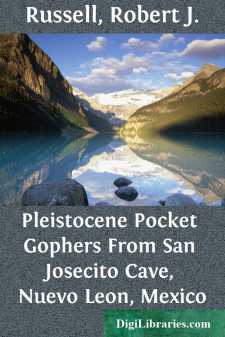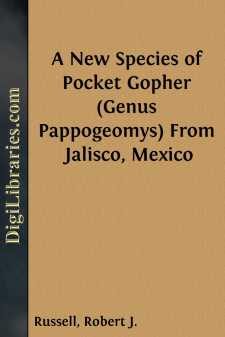Categories
- Antiques & Collectibles 13
- Architecture 36
- Art 48
- Bibles 22
- Biography & Autobiography 813
- Body, Mind & Spirit 142
- Business & Economics 28
- Children's Books 15
- Children's Fiction 12
- Computers 4
- Cooking 94
- Crafts & Hobbies 4
- Drama 346
- Education 46
- Family & Relationships 57
- Fiction 11828
- Games 19
- Gardening 17
- Health & Fitness 34
- History 1377
- House & Home 1
- Humor 147
- Juvenile Fiction 1873
- Juvenile Nonfiction 202
- Language Arts & Disciplines 88
- Law 16
- Literary Collections 686
- Literary Criticism 179
- Mathematics 13
- Medical 41
- Music 40
- Nature 179
- Non-Classifiable 1768
- Performing Arts 7
- Periodicals 1453
- Philosophy 64
- Photography 2
- Poetry 896
- Political Science 203
- Psychology 42
- Reference 154
- Religion 513
- Science 126
- Self-Help 84
- Social Science 81
- Sports & Recreation 34
- Study Aids 3
- Technology & Engineering 59
- Transportation 23
- Travel 463
- True Crime 29
Pleistocene Pocket Gophers From San Josecito Cave, Nuevo Leon, Mexico
Description:
Excerpt
Cueva de San Josecito in the province of Aramberri, near the town on Aramberri, Nuevo León, México, is at an elevation of approximately 7400 feet above sea level on the east-facing slope of the Sierra Madre Occidental in a limestone scarp. The dominant vegetation about the cave is the decidedly boreal forest association of pine and live oak. Additional information concerning the cave is provided by Miller (1943:143-144).
Animal remains recovered from San Josecito Cave are among the most important Pleistocene finds in México, and include the most extensive collection of Pleistocene geomyids. The vertebrate remains are probably late Pleistocene in age; certainly they are post-Blancan, since the genera Equus, Preptoceras, Smilodon, and Aenocyon (all Pleistocene genera) are present. According to Miller's (loc. cit.:145) extensive report on the avifauna, the bird remains from the cave are a remarkable assemblage and beautifully preserved. Most of the mammalian remains have been studied in detail, and the results of these studies have been published in a number of papers each treating specific groups. These reports provide valuable information concerning the distribution of mammals in northeastern México in the late Pleistocene, a knowledge of which is most important to an understanding of present patterns of distribution and evolution of Mexican mammals.
Cushing's (1945:182-185) report on his study of the rodents and lagomorphs includes a description of an extinct pygmy species of rabbit, Sylvilagus leonensis. He records three kinds of pocket gophers from San Josecito; Cushing was able to separate the genus Thomomys from two unidentified geomyids (loc. cit.:185). These prove to belong to the genera Cratogeomys and Heterogeomys; the materials are described below. Cushing records also larger mammals, including the antilocaprid (Stockoceros conklingi), saber-toothed cat (Smilodon), dire wolf (Aenocyon), a large oviboid (Preptoceras), and deer (loc. cit.:182).
More recently Findley (1953:633-639) has written on the remains of the family Soricidae taken from the cave, and Hooper (1952:59) has studied the bones of the genus Reithrodontomys and found them not different from those of R. megalotis that inhabits the region of the cave today. Handley (1955:48) has described a new species of plecotine bat, Corynorhinus tetralophodon, from the collection. Jones (1958:389-396) published an account of the bats of San Josecito, and described a new vampire bat, Desmodus stocki, from the cave. Jakway (1958:313-327) has reported on the lagomorphs and rodents in detail, and compared this part of the cave fauna with that of Rancho La Brea and Papago Spring Cave, Arizona. Jakway (lit. cit.:323-324) suggests that the fauna from San Josecito is late Pleistocene, probably contemporaneous with the remains from Papago Spring Cave and pre-Rancholabrean.
I thank Professor E. Raymond Hall and Dr. Robert W. Wilson for their permission to examine this material and for critical comments and advice on the manuscript. The drawings were made by Miss Lucy Remple. The specimens are a part of the collection of fossil vertebrates formerly belonging to the California Institute of Technology, but now the property of the Los Angeles County Museum. The specimens had been lent by the late Professor Chester Stock to Professor Hall and Dr. Wilson for study and report. All measurements herein are in millimeters....




